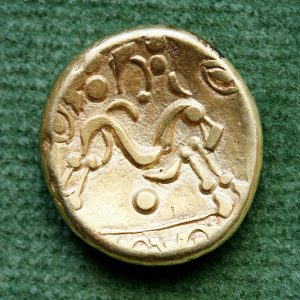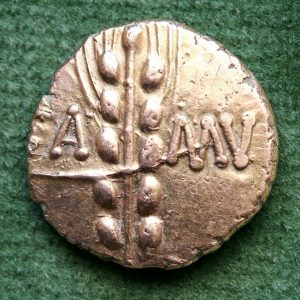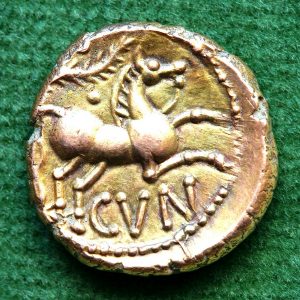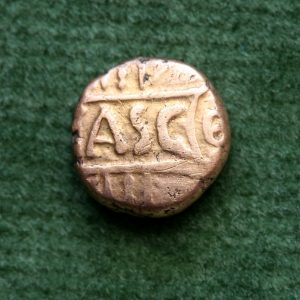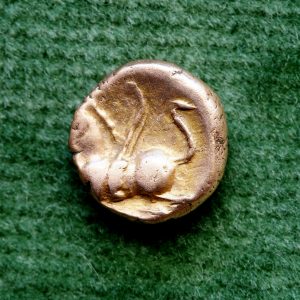<Roman Coins Iron Age Silver Coins >
Celtic (late Iron Age) Gold Coins with Probable Religious Significance
- Ambiani Gold Stater, Celtic horse
- Cunobelin Gold Stater, Celtic horse
- Tasciovanus Gold Quarter Stater. Flying horse
Lovely and comparatively rare coins such as the three Staters illustrated here were struck to raise money for various conflicts such as the Gallic Wars 58-50 BC, or simply to raise money for Celtic tribal kings, in these cases King Cunobelin, Celtic king of the Catuvellauni tribe or his father King Tasciovanus. They were objects of high value when they were struck and would also have had a votive role, offered or sometimes buried for a religious purpose, perhaps to bring a good crop or ensure that the power of the gods would be lent to a forthcoming battle.
1. Ambiani Gold Stater, Celtic Horse.
Description and Comment:
Obverse: There is no image, just a blank. The obverse of coins such as this usually show a head, but during the Gallic Wars these were made in haste, with one side only stamped, to help pay those fighting against Julius Caesar’s army in Gaul. They were struck by the seafaring tribe known as the Ambiani and their capital was at Samarobriva which corresponds to the modern city of Amiens in France. This coin probably helped pay those opposing Caesar’s invasions of Britain, 55 and 54 BC.
Reverse: The reverse is a beautifully designed stylised horse galloping right with typical Celtic patterns. Gallic War Ambiani, 3rd Variety type. Stylised horse galloping right. The Ambiani were consummate minters and their coinage was to be found right across the Belgic tribes inclusive of Britain.
Dimensions and Details: No details
Found: 9 October 2009. Alconbury area.
Date: 100-50 BC. This coin circa 55-52 BC.
Diameter: 17 mm.
Weight: 6.14gm.
VA 50-1 class 2. CCI 09-3502
VA refers to Robert van Arsdell author of Celtic Coinage of Britain, which contains a numbering system. CCI refers to the Celtic Coinage Index.
2. Cunobelin Gold Stater, Celtic horse.
Description and comment:
Obverse: Cunobelin followed in his father’s footsteps as a Celtic King of the Catuvellauni tribe in approximately 10 AD, reigning until the 40s AD. This was the strongest tribe in Southern Britain, who under Cunobelin took control of the Trinovante tribe and their capital Camulodunum, (Colchester), shown on this coin as (C) AMV, the C on the left is only part visible. The wheat ear is a cultivated one. Wheat has a commodity value and indicates wealth. Shakespeare’s play Cymbeline is thought to be based on King Cunobelin.
Reverse: The reverse has the letters CVN which is short for CUNOBELIN, below a horse galloping to the right (wealth on the hoof). There is a rein and a ladder style mane with a typically Celtic leaf with dot design above the horse’s back. The impression is very fine. Cunobelin’s name means Hound of Benelus made up of Cuno – (hound) and Benelus. The coin, which was found in an arable field may have been buried in that field as an offering for a good grain crop.
Dimensions and Details:
Gold Stater Obverse: Cunobelin coin, 10-40 AD. This coin circa 20 AD. CAMV. Die cast flaw. Ear of wheat on stalk. CC108-9329
Gold Stater Reverse: CVN, Horse with rein, ladder mane, with leaf and dot design. VA 1925-01. Wheat type.
Found: October 15 2008. Near Haslingfield, Cambridgeshire.
Date: Cunobelin 10-40 AD. This coin circa 20 AD.
Diameter: 16mm.
Weight: 5.37gm.
VA 1925-01 Celtic Coin Index (CC1) as CC1 08 – 9329.
3. Tasciovanus Gold Quarter Stater. Flying horse.
Description and comment:
Gold quarter stater obverse: King Tasciovanus approximately 20 BC – 9 or 10 AD. Tasciovanus was the father of unobelin and King of the Catuvellauni from about 20 BC to approx 9 or 10 AD. He ruled from Verulamium, modern day St. Albans in Hertfordshire. The coin obverse shows the abbreviation for his name, [T] ASC in the Banner across the coin with a wreath behind. There is a pellet in the ring motif on either side of the Banner (only part on the right is showing). The coin is very small, being a Quarter Stater and thus difficult to get a complete design impressed upon it.
Reverse: The reverse depicts a winged horse moving to the left, although on this example only the neck, body wing and tail are showing. This coin is smaller than the 12mm versions generally found, although the weight is close to the 1.4gm expected. Therefore, it is thicker, rather than as wide as it could be.
Dimensions and Details:
Found: October 17 2009. Near Godmanchester.
Date: Tasciovanus BC 20 -10 AD. Coin circa 1-10 AD.
Diameter: 10mm.
Weight: 1.36gm.
VA 1786-1, CC1 09-3510 CCI refers to the old Celtic coin index.

